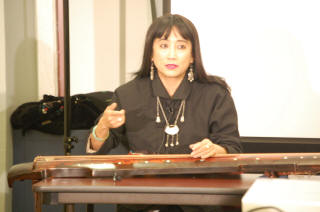
The qin, the Ancient Chinese seven stringed zither is one of the four refined arts traditionally pursued for self-cultivation. (The other three are painting, calligraphy, and chess.) Dr. Mingmei Yip will discuss the interrelation of two of these arts: qin and calligraphy. Chinese aesthetic theories of the two arts will be discussed, especially the abstract beauty of notes and lines and the imitation of animals and objects in nature. Interplay between the yin/yang polarity of empty and full will also be explored.
The presentation will include both performance on the qin with vocal accompaniment and demonstrations of calligraphy.
Program
Drinking Spree
This composition is attributed to Ruan Ji, one of the seven literati of the Bamboo Groves in the Wei Dynasty. To avoid political entanglement, Ruan spent his time playing the qin, pretending to be drunk and mad. The late qin master Yao Bingyan (1921-1983) reconstructed this piece from the qin manual Shenqi Mipu (Marvelous and Mysterious Qin Handbook , 1425). He settled the score by using the triple meter, which is otherwise unknown in qin music.
Three Variations of the Plum Blossom
The earliest score of this piece was published in “Wondrous Esoteric Qin Handbook” (1425). In Chinese culture, plum blossom, symbolizing a gentlemen’s virtue — lofty and righteous, is beloved by poets, artists and qin players. This piece has two themes, a melodious harmonic section extolling the steadfastness symbolized by the plum blossom and a quick and animated section expressing its bravery of surviving the harshness of winter. The harmonic section is repeated in the low, middle, and high registers respectively accounting for the name of the piece. My version is from the Spring Grass Pavilion Qin Handbook (1744 ).
Evening Cry of the Raven
In ancient China, the raven’s cry was considered an auspicious sign. During the Northern and Southern Dynasties (420-589), the Duke Liu Yiqin’s life was under threat because the King was jealous of him. The evening as he was about to flee the country, he heard the raven’s cries. His concubine considered this a good sign and predicted that he would go free. She was later proved to be right. This is a virtuoso piece which fully explores the performer’s finger dexterity.
Flowing Water
This is a virtuoso piece which imitates the different images of flowing water.
Immortal of the Magpie Bridge
Lyrics: Qin Guan (1049-1100)
Music/translation: Mingmei Yip
This is the Song dynasty (960-1279) poet Qin Guan’s most famous love song. It expresses the pain and suffering of two separated lovers.
Delicate clouds scamper above on the seventh evening of the seventh month
Falling stars carry my bitterness,
secretly traversing the remote Milky Way.
Meeting but once amidst the autumn wind and the dews drops
surpasses endless encounters on earth.
Love is tender as water
Our wedding day is a distant dream
Dejected, I watch the magpies return.
If love between two people is to last,
Must they see each other day and night?
If love between two people is to last
Must they see each other day and night?
URL: www.mingmeiyip.com

